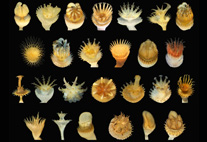Abstract
Hydroides Gunnerus, 1768 is the largest and one of the economically most important genera of calcareous tubeworms (Serpulidae, Annelida) that includes a number of notorious fouling and bioinvading species. Although the representatives of the genus are typically found in shallow waters of tropical and subtropical areas worldwide, the species composition of the genus in Australia has never been revised. We conducted the first detailed regional taxonomic revision of Hydroides species based both on the historical collections from Australian museums (Australian Museum, Museum Victoria, South Australian Museum, Western Australian Museum, Queensland Museum, and Museum and Art Gallery of Northern Territory) and newly collected material from New South Wales, Victoria, Queensland, Northern Territory, and Western Australia. In total, 25 species are currently considered valid in Australia, including three new species: H. amri n. sp. from NSW, SA, and Vic (previously referred to as H. cf. brachyacantha), as well as H. glasbyi n. sp. and H. qiui n. sp., both from NT, and two new records of H. furcifera and H. multispinosa for Australia. We have synonymised H. spiratubus with H. albiceps, and H. spiculitubus with H. tambalagamensis in this study. The status of the taxon H. cf. recta remains undecided. An identification key and diagnoses accompanied by original high-quality photographs for all species recorded in Australia are provided. Application of molecular genetics is needed to resolve the status of some problematic species.

